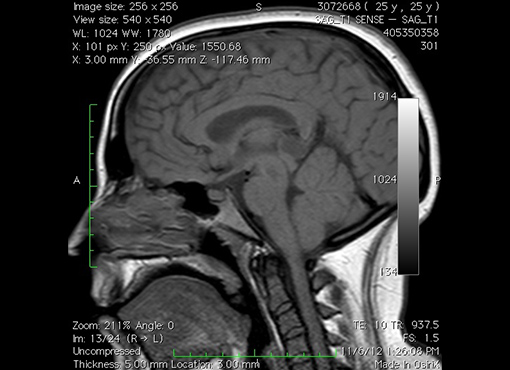
What is Chiari Malformation?

Chiari malformation is a congenital (i.e., present at birth) structural problem at the base of the skull that affects the brain and spinal cord. In fact, it is not a malformation of the brain at all. More accurately, the lower portion of the skull, the portion known as the posterior fossa, is too small to accommodate the lower portion of the brain. As a result, the portion of the cerebellum called the tonsil is forced to protrude into the spinal column. This results in a compression of the brainstem and spinal cord. It is the compression of the brainstem and spinal cord that is primarily responsible for the symptoms. We have learned that even minimal protrusion of the cerebellar tonsils can cause symptoms
Our Approach to Chiari Malformation
Chiari malformation has always been classified as a rare disease and is officially reported to occur in less than 1% of the population. The actual occurrence of Chiari malformation in the general population is in fact unknown. Why? First, we do not yet know how to best define the problem. Second, many neurosurgeons with extensive experience in treating Chiari malformation have come to learn that the current criteria for diagnosing Chiari on an MRI scan are much too strict. As a result, many patients go undiagnosed. Rather than focus on the position of the cerebellar tonsils as shown on the MRI scan, we have come to view the problem as the result of the compression of the brainstem or spinal cord at the base of the skull. This may occur even if the tonsils of the cerebellum protrude through the foramen magnum by as little as 1 mm. In fact, patients with the smaller Chiari malformations may have more symptoms than those with the larger Chiari malformations.
| Symptom | Less than 3mm | 3-5mm | More than 5mm |
|---|---|---|---|
| 97 patients | 148 patients | 183 patients | |
| % | % | % | |
| Headache | 95 | 99 | 98 |
| Dizziness | 78 | 79 | 78 |
| Nausea | 68 | 67.7 | 52 |
| Facial pain | 69 | 52 | 40 |
| Arm numbness | 69 | 60 | 57 |
| Arm tingling | 74 | 69 | 67 |
| Leg Numbness | 63 | 57 | 47 |
| Leg tingling | 70 | 63 | 56 |
| Arm pain | 77 | 60 | 59 |
| Leg Pain | 80 | 64 | 56 |
| Neck pain | 95 | 97 | 92 |
| Disturbed balance | 77 | 74 | 73 |
| Memory impairment | 84 | 85 | 85 |
Our studies have shown that the neurological symptoms of Chiari malformation may also occur because of other disorders such as cervical stenosis, tethered cord syndrome, and syringomyelia. These different disorders may occur independently of Chiari malformation but frequently occur in conjunction with the Chiari malformation.
We have to prioritize the conditions that we diagnose from the most severe to the least severe. In this manner, we can select that treatment that is likely to have the greatest benefit for the patient. Each of these conditions is diagnosed by MRI imaging. Newer imaging techniques, some developed by Dr. Heffez and his radiology colleagues, have improved our ability to recognize brainstem compression and spinal cord compression.
If you are a new patient, please contact us.
